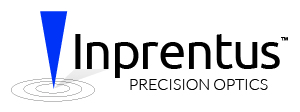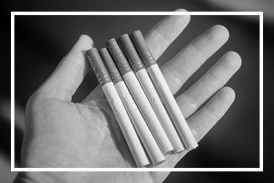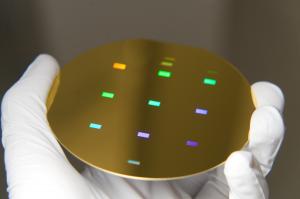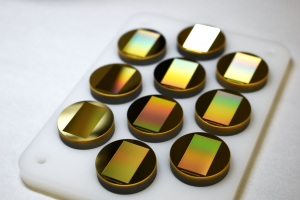Inprentus Delivers Volume Product Lines for Sensing, Augmented Reality, and Semiconductor Applications

Inprentus, maker of ground-breaking custom blazed diffraction gratings, continues to serve customers by creating higher volume, smaller gratings for new markets
In addition to the ability to make highly specialized large diffraction gratings, Inprentus has increasingly been sought after for higher volume production of ultra-precise smaller gratings. Compared to soft X-ray gratings, where the customer’s source light beam has a large area footprint necessitating large gratings, markets in other applications require smaller area gratings. For example, augmented reality requires multiple small gratings on the same substrate in a “step and repeat” process, and sensing or semiconductor applications require identical single gratings on multiple substrates. “Inprentus uses mechanical ruling technology, and this technology is very flexible in terms of handling a “step and repeat” on one substrate or multiple substrates” says Cody Jensen, Chief of Engineering at Inprentus. “Inprentus has been increasingly sought after by customers to create gratings in higher volume. The challenges for quality assurance are different when going into volume production; however we have welcomed the challenge and have exceeded customer expectations in innovating every step, from design to production set-up and implementation, to metrology”.
Inprentus’ first foray into volume production was facilitated by orders from customers in the rapidly emerging area of Extreme Ultra-violet (EUV) lithography, a technology that fabricates ultra-small features on semiconductor chips. This technology is now used by every major computing technology in the world for cutting edge applications like artificial intelligence. “Due to the flexibility of mechanical ruling that a blazed grating provides the market, we are able to provide grating based solutions for applications all the way from Soft X-ray, Deep Ultra-violet and Visible Light, to Infrared and Far-Infrared Light. Inprentus has a very wide spectrum of grating solutions to facilitate innovations at the heart of humanity’s technological future, and the demand is only going to go up from here” says Subha Kumar, Chief Operating Officer of Inprentus.
“Delivering these volume orders is a big win for the company but there was never a doubt that we could achieve this. For a company known for making the likes of Ferraris for the optics world, making our product in volume is all about executing the plan” says Jeff MacDonald, the interim CEO.
Inprentus designs, manufactures, and sells X-ray and EUV diffraction gratings for a variety of scientific and commercial applications by companies, academic institutions, and government laboratories around the world. Inprentus was founded in June 2012 to commercialize an innovative, nano-scale lithography technology using mechanical deformation of metallic surfaces. Inprentus aims to apply 21st century mechanical ruling to solve critical current and future grating-centered challenges. Inprentus is a disruptive technology company that will lead the manufacturing of next-generation diffraction gratings. We are committed to excellence, risk, and pushing boundaries by providing state-of-the-art blazed gratings that perform to unprecedented specifications and that enable novel applications. Outcomes include next-generation monochromators, spectrometers, laser systems, and analytical instrumentation in defense applications, as well as ground-breaking consumer experiences enabled by improvements in chip manufacturing and see-through AR waveguides. We are dedicated to facilitating next-level science and technology by continually enhancing our capabilities with cutting-edge developments, collaborations, and partnerships. The Inprentus team truly exemplifies an unwavering belief in the power of can-do creativity, perseverance, and excellence.
Cynthia Ottemann
Inprentus, Inc
+1 217-239-9862
email us here
Legal Disclaimer:
EIN Presswire provides this news content "as is" without warranty of any kind. We do not accept any responsibility or liability for the accuracy, content, images, videos, licenses, completeness, legality, or reliability of the information contained in this article. If you have any complaints or copyright issues related to this article, kindly contact the author above.
Process Insights Launches Trace-1000S/N Sulfur-Nitrogen Gas Analyzer
When people repeatedly read sentences, they get faster and more accurate, showing the brain improves with practice
Colle AI Scales User Access With New Creator-First NFT Features
Kalendarium
Więcej ważnych informacji
 Jedynka Newserii
Jedynka Newserii

 Jedynka Newserii
Jedynka Newserii

Medycyna

Komisja Europejska pracuje nad nową dyrektywą tytoniową. Papierosy w Polsce mogą znacznie podrożeć
W Brukseli trwa dyskusja nad zmianami w unijnej dyrektywie tytoniowej. Minimalna stawka akcyzy na paczkę papierosów w UE może wzrosnąć nawet dwukrotnie: z 1,8 euro do 3,6 euro. Doprowadziłoby to do wyrównania cen papierosów pomiędzy państwami UE. Wzrost cen byłby najbardziej dotkliwy dla palaczy z tych państw, które przystąpiły do UE w 2004 roku, w tym Polski, z uwagi na znacznie niższy udział akcyzy w cenie paczki papierosów niż nowe minima unijne. Nad Wisłą paczka papierosów mogłaby kosztować nawet ok. 40 zł. Nowa dyrektywa tytoniowa może zostać otwarta już podczas duńskiej prezydencji w Radzie Unii Europejskiej.
Regionalne – Wielkopolskie
Brakuje decyzji KOWR o przyszłości dzierżawionej ziemi rolnej. To zagrożenie dla polskiego rolnictwa i zatrudnionych w nim pracowników

Brak wiążących decyzji urzędników KOWR w podejmowaniu decyzji dotyczących losów gruntów zdawanych do Zasobów Skarbu Państwa może oznaczać likwidację strategicznej infrastruktury. Demontaż obiektów rolniczych i grupowe zwolnienia stanowią zaś zagrożenie dla polskiego rolnictwa. Pracownicy Top Farms, którzy protestowali przed siedzibą KOWR w Poznaniu, alarmują, że dalsza zwłoka w podejmowaniu decyzji administracyjnych doprowadzi do zwiększenia zależności od zagranicznych dostawców.
Problemy społeczne
Sztuczna inteligencja napędza innowacje, ale pochłania ogromne ilości prądu. Rośnie potrzeba bardziej energooszczędnych rozwiązań

Trenowanie dużych modeli językowych, takich jak ChatGPT, wymaga ogromnych zasobów obliczeniowych, co przekłada się na znaczące zużycie energii, porównywalne z roczną konsumpcją małych państw. Eksperci podkreślają, że konieczne jest projektowanie bardziej energooszczędnych algorytmów i systemów, które ograniczą ślad węglowy AI. Jednocześnie sztuczna inteligencja może też wspierać działania na rzecz klimatu, pomagając w optymalizacji zużycia energii i efektywniejszym zarządzaniu zasobami.
Partner serwisu
Szkolenia

Akademia Newserii
Akademia Newserii to projekt, w ramach którego najlepsi polscy dziennikarze biznesowi, giełdowi oraz lifestylowi, a także szkoleniowcy z wieloletnim doświadczeniem dzielą się swoją wiedzą nt. pracy z mediami.









.gif)

 |
| |
| |
|